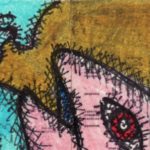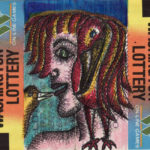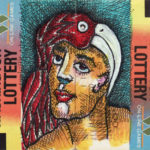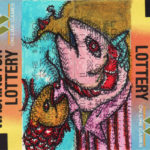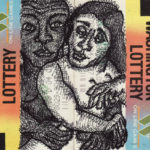Previous Art: Arturo Artorez “Drawing Numbers” Opening Thursday, October 9, 2014 6-9pm
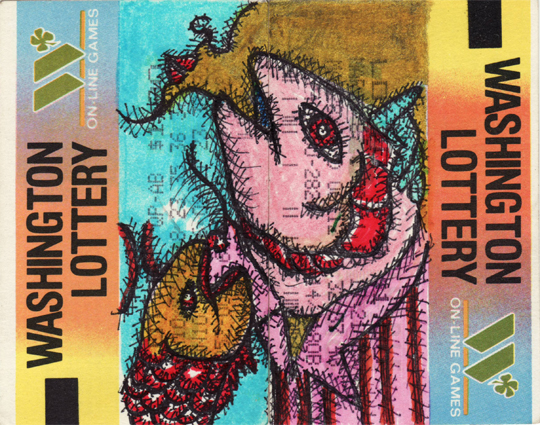
In this series of un-exhibited work, Arturo Artorez (b. 1940) presents a full body of drawings done entirely on lottery tickets – over 96 individual pieces. The depth of the work is subtle: each is unique, random and embodies a series of events that once held promise. They represent a snapshot in time and an element of chance that is impossible to recreate, especially since lottery tickets are now printed on thermal paper and these were collected in 1988. Most of the numbers are obscured by the medium (pen ink, markers). His style incorporates elements of surrealism, magical realism, expressionism and cubism.
“No one has ever lost in the lottery. Even if one doesn’t win the prize, the purchase of the ticket contributes to advance projects that benefit the public and, in this way, nobody loses. I too have played, and have always lost. But, I’ve also won a small surface to make art and recycle dreams.” – Arturo Artorez
About the fundraiser:
In an incident that Arturo is hesitant to discuss, he was the victim of a mugging on Friday, September 19, 2014 while walking home. He was robbed of his phone, wallet, iPad and glasses. We are trying to help him replace over $1000 worth of personal items, so consider a donation if you are not able to purchase art. Any amount helps and this is entirely on his behalf.
KIRO 7 TV coverage of the incident.
About Arturo Artorez:
Arturo Artorez was born and raised in Mexico City, where he also received his formal education. Time and chance put him in Israel in the summer of 1967, at the exact moment when the Six-Day War erupted on June 5, a combat in which he was forced to participate. After such a horrifying and fortunately brief experience, Artorez was put aboard a ship and sent to America, landing first in San Diego, California and then in Tijuana, Baja California. After spending nearly a month there, he returned to Mexico City where he immediately became involved in the student movement and the popular protest that resulted in the fateful Night of Tlatelolco—the massacre on October 2, 1968, when the Mexican army encircled protesters in the Plaza of the Three Cultures and proceeded to kill some 300 persons, according to official estimates, and arrested 1,300 others with Artorez among them.
Dodging death in an almost fantastic if not miraculous fashion, Artorez left Mexico along with some of the other activists when President Salvador Allende offered them asylum and sent two Chilean Air Force planes to transport them. Arturo left for Ecuador almost immediately only to experience the military coup that deposed president Velasco Ibarra and ushered General Rodriguez Lara into power in February of 1972. Once again, the artist escaped the chaos that followed the coup and after some remarkable adventures, returned to Mexico City. Four years later in 1976 he moved to Seattle, where he has lived ever since.
By the time he arrived in Seattle, Artorez was already an accomplished artist. His works had been exhibited in Canada, Chile, Cuba, Ecuador, France, The United States, Mexico and Peru – at times alongside masters such as Cuevas, Tamayo, Toledo and Guayasamín. His acknowledgments included an honorable mention at the Sixth “Paris Biennial of Young Painters,” and art critics in Mexico and elsewhere augured him an auspicious future, “A career that promises to be brilliant,” wrote one of them at a given point.
In 1988, the same vicissitudes that many artists often face in their struggle to survive while also continuing to practice their craft compelled Artorez to take a job as a security guard at the Seattle Art Museum. To relieve boredom, he began to create ink and pencil drawings on the time cards that the museum used to record the employees’ working hours. He also used other “recyclable” materials such as discarded artwork labels. Similarly, at around the same time he started painting on expired lottery tickets.
The images on the time cards often show mysterious beings and settings—a mental escape from boredom and oppressive drudgery the artist-turned-security-guard must endure day after day. The transformation of a utilitarian object (moreover, one that is an instrument of control) into an aesthetic entity becomes and act of liberation, even if only fleetingly. Most compelling are the characters that Artorez portrays on the lottery tickets. In his consistently figurative style, he depicts a number of beings that inhabit a surreal, almost phantasmagoric realm. On an immediate level we recognize this world as Seattle’s Capitol Hill, but it can easily translate into any other urban setting the U.S. or elsewhere. In the midst of a precarious existence, many of these characters set their sights on the wheel of fortune, perhaps the only “escape” they have left. Among them we find a man whose eyes are encircled by the two “o” letters in the word “Lotto” (his sight firmly set on the elusive prize.) Another, an old fellow smoking a cigarette and holding a beer bottle, bears the word “Million” inscribed on his forehead—his fantasies going up in smoke at his side.
A good deal of irony permeates the Arturos visual commentaries on both the time cards and the lottery tickets. These poignant statements also allude to the existential condition of the painter himself. Thus, his life experiences and current circumstance become beautifully conjugated with his artistic subjects.
(Excerpted from the catalog, “Time and Chance” by Lauro Flores, University of Washington.
Category: Art

